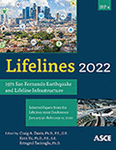Preliminary National-Scale Seismic Risk Assessment of Natural Gas Pipelines in the United States
Publication: Lifelines 2022
ABSTRACT
Although the gas pipeline infrastructure in the United States is vulnerable to the seismic hazards of (i) strong ground shaking, and (ii) ground failures induced by surface faulting, liquefaction, or landslides, limited national guidance exists for operators to consistently evaluate the earthquake response of their pipelines. To provide additional information for stakeholders and establish more consistency at a national scale, we attempt to quantify seismic risk for gas transmission pipelines in the conterminous United States using a metric such as average annual loss, which helps readily distinguish geographic areas of high and low relative risk. Specifically, we integrate the 2018 National Pipeline Mapping System, the 2018 National Seismic Hazard Model, and several candidate models from the literature for estimating pipeline damage. Through this effort, we highlight major research needs for ultimately reducing the many uncertainties associated with a comprehensive seismic risk assessment of gas pipelines.
Get full access to this article
View all available purchase options and get full access to this chapter.
REFERENCES
ALA (American Lifelines Alliance). (2001). Seismic fragility formulations for water systems Part 1 - Guideline.
ALA (American Lifelines Alliance). (2005a). Guideline for assessing the performance of oil and natural gas pipeline systems in natural hazard and human threat events.
ALA (American Lifelines Alliance). (2005b). Guideline for assessing the performance of oil and natural gas pipeline systems in natural hazard and human threat events Part 2 - Commentary.
ATC (Applied Technology Council). (2016). Critical assessment of lifeline system performance: Understanding societal needs in disaster recovery (NIST GCR 16-917-39).
ASME. (2018). Gas Transmission and Distribution Piping Systems (ASME B31.8-2018). New York, NY: American Society of Mechanical Engineers.
Eidinger, J. M. (2020). Seismic fragility of natural gas transmission pipelines and wells.
FEMA. (2012). Multi-hazard loss estimation methodology: Earthquake model (Hazus-MH 2.1 Technical Manual). Washington, D.C.
Honegger, D. G., and Nyman, D. J. (2004). Guidelines for the seismic design and assessment of natural gas and liquid hydrocarbon pipelines. Houston, TX.
Honegger, D. G., and Wijewickreme, D. (2013). “Seismic risk assessment for oil and gas pipelines.” Chapter 25 in Handbook of Seismic Risk Analysis and Management of Civil Infrastructure Systems, S. Tesfamariam and K. Goda, eds.
Idriss, I. M., and Boulanger, R. W. (2008). Soil liquefaction during earthquakes (2nd ed.). Earthquake Engineering Research Institute.
INGAA (Interstate Natural Gas Association of America). (2016). Safety of Gas Transmission Pipeline Rule Cost Analysis.
Jaiswal, K. S., Bausch, D., Rozelle, J., Holub, J., and McGowan, S. (2017). Hazus estimated annualized earthquake losses for the United States (FEMA P-366).
Kavazanjian, E., Wang, J.-N. J., Martin, G. R., Shamsabadi, A., Lam, I. P., Dickenson, S. E., and Hung, C. J. (2011). LRFD Seismic Analysis and Design of Transportation Geotechnical Features and Structural Foundations.
Lanzano, G., Salzano, E., de Magistris, F. S., and Fabbrocino, G. (2013). “Seismic vulnerability of natural gas pipelines.” Reliability Engineering & System Safety, 117, 73–80.
Lanzano, G., Salzano, E., De Magistris, F. S., and Fabbrocino, G. (2014). “Seismic vulnerability of gas and liquid buried pipelines.” Journal of Loss Prevention in the Process Industries, 28, 72–78.
O’Rourke, T. D., and Palmer, M. C. (1996). “Earthquake performance of gas transmission pipelines.” Earthquake Spectra, 12(3), 493–527.
Petersen, M. D., Shumway, A. M., Powers, P. M., Mueller, C. S., Moschetti, M. P., Frankel, A. D., and Zeng, Y. (2019). “The 2018 update of the US National Seismic Hazard Model: Overview of model and implications.” Earthquake Spectra, 36(1), 5–41.
Pineda-Porras, O., and Najafi, M. (2010). “Seismic damage estimation for buried pipelines: Challenges after three decades of progress.” Journal of Pipeline Systems Engineering and Practice, 1(1), 19–24.
PHMSA (Pipeline and Hazardous Materials Safety Administration). (2017). National Pipeline Mapping System Standards for Pipeline, Liquefied Natural Gas and Breakout Tank Farm Operator Submissions.
PHMSA (Pipeline and Hazardous Materials Safety Administration). (2020). “Pipeline Mileage and Facilities.” <https://www.phmsa.dot.gov/data-and-statistics/pipeline/pipeline-mileage-and-facilities>(Feb. 12, 2020).
Psyrras, N., Kwon, O., Gerasimidis, S., and Sextos, A. (2019). “Can a buried gas pipeline experience local buckling during earthquake ground shaking?” Soil Dynamics and Earthquake Engineering, 116, 511–529.
Tsinidis, G., Di Sarno, L., Sextos, A., and Furtner, P. (2019). “A critical review on the vulnerability assessment of natural gas pipelines subjected to seismic wave propagation. Part 1: Fragility relations and implemented seismic intensity measures.” Tunnelling and Underground Space Technology, 86, 279–296.
Wald, D. J., and Allen, T. I. (2007). “Topographic slope as a proxy for seismic site conditions and amplification.” Bulletin of the Seismological Society of America, 97(5), 1379–1395.
Information & Authors
Information
Published In
History
Published online: Nov 16, 2022
Authors
Metrics & Citations
Metrics
Citations
Download citation
If you have the appropriate software installed, you can download article citation data to the citation manager of your choice. Simply select your manager software from the list below and click Download.
